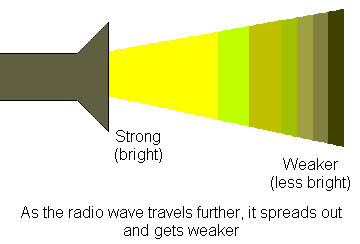



| |
Section 5
Propagation
Before we start consider this:
![]() The subject of propagation, which in plants is how the
plant moves through the earth and then out into the air, with Radio Wave
it is how radio waves travel from the antenna through the air
(atmosphere). The aim is to transmit and receive a good signal. On HF,
it is often desirable to efficiently radiate and receive a strong signal
over long distances known by the amateur radio term of as "working DX".
International communications are made possible by the HF radio waves
bouncing off of part of the atmosphere called the ionosphere. Amateur
radio stations deliberately operate on HF to use the properties of the
ionosphere to achieve long distance communications.
The subject of propagation, which in plants is how the
plant moves through the earth and then out into the air, with Radio Wave
it is how radio waves travel from the antenna through the air
(atmosphere). The aim is to transmit and receive a good signal. On HF,
it is often desirable to efficiently radiate and receive a strong signal
over long distances known by the amateur radio term of as "working DX".
International communications are made possible by the HF radio waves
bouncing off of part of the atmosphere called the ionosphere. Amateur
radio stations deliberately operate on HF to use the properties of the
ionosphere to achieve long distance communications.
For positioning an antenna, the higher the better - this is why antennas are often on masts. Ideally, the antenna is high enough for the radio wave to clear obstacles e.g. hills and buildings that absorb the radio signal. Greater antenna height is an advantage for both receiving and transmitting. A radio wave is absorbed by obstacles - for example a mobile station will lose radio contact when entering a tunnel.
5A1 Recall that radio waves normally travel in straight lines.
It is a fact that as Radio waves travel, or we can use the word propagate, they travel in straight lines, unless diffracted or reflected
Recall
that they can be refracted, diffracted and reflected.
Diffraction refers to the bending of radio waves in the ionosphere and if the bending is very great the wave almost get bent right back a bit like reflection.
So Diffraction or bending; Reflection means that the direction of the radio wave is changed e.g. a HF signal that is moving away from the Earth (towards outer space) is diffracted; or reflected back to the Earth by the ionosphere where it can be received by a station far away from the transmitting station.
Recall
that radio waves get weaker as they spread out.

The effect is the same as a bean of light from a torch - at a distance away from the torch, the same light has to cover a greater area so it is less intense. The light from the torch widens and fades away.
5A2 Recall that VHF and UHF signals normally pass through the ionosphere.
You need to understand that VHF and UHF radio frequency signals pass through the Ionosphere as this is how communication takes place to space ship travelling far beyond the earth's atmosphere. If this did not happen then no communication could take place, but we know it does.
The origin of some of the text on this page is from the RSGB with additions by the web master